The Spit of Nizhny Novgorod ('Strelka') is a unique geographical and historical territory at the confluence of the great rivers Volga and Oka. For a long time, the Spit was inaccessible to citizens, but soon it may become a new point of attraction and a city symbol.
In 2021, the territory will be improved according to the IRGSNO concept.
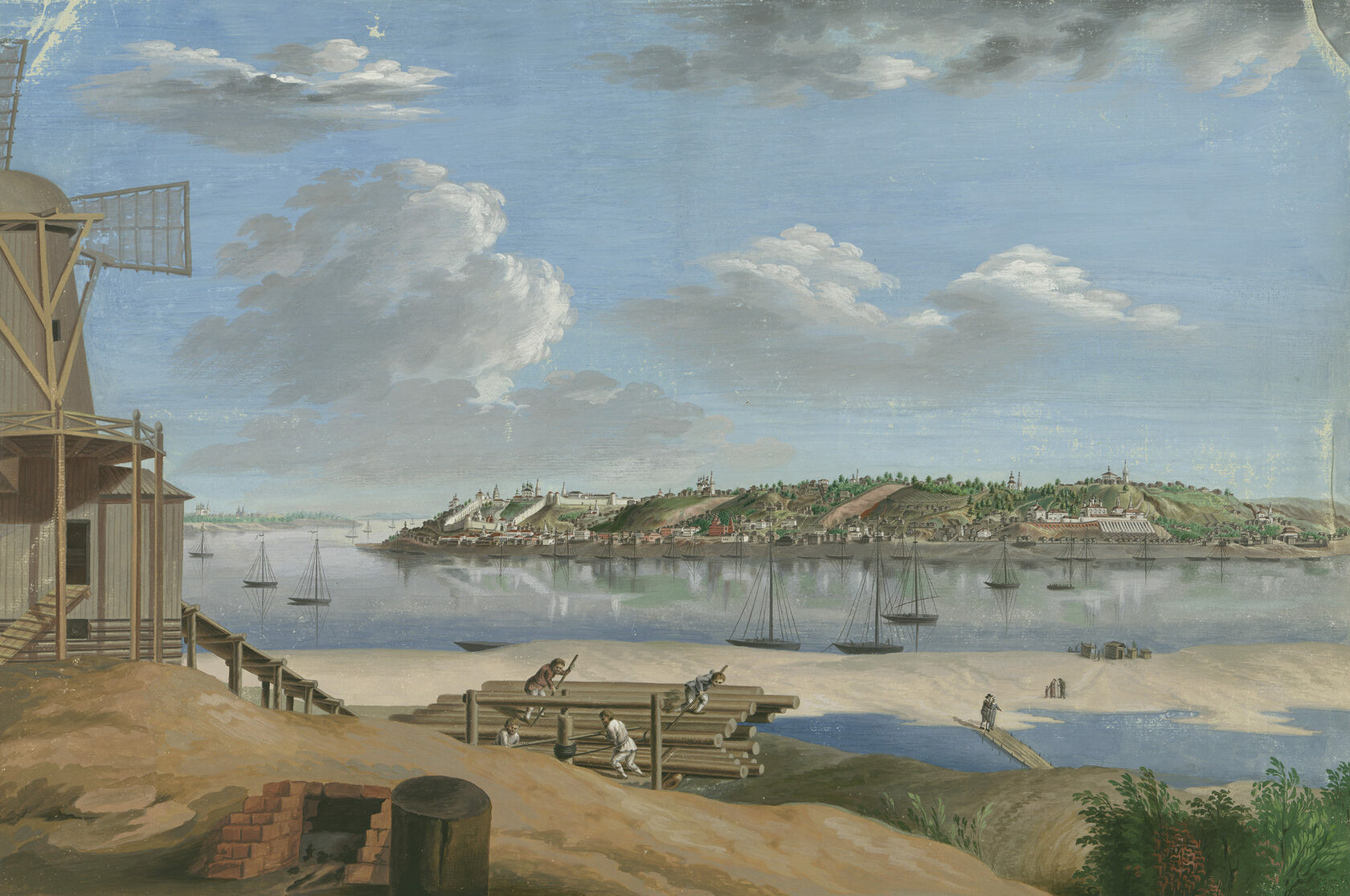
Prior to the beginning of the 19th century, the Spit was considered an urban area. There were lakes, grassland meadows, smithies, and mills here. In 1817, the Makaryevskaya fair was moved to the left bank of the Oka River. The Spit became a part of the fair and developed first as a place for berthing and storage, and then as a multifunctional area complete with a cathedral, hotels, and for that matter, the rows of shopping stalls.
In 1929, the fair was closed as a ‘socially alien phenomenon,’ and the Gorky river cargo port was located in that area, becoming an important strategic transportation hub on the north-south and west-east routes for eight decades. The port was a closed, restricted access site, but the silhouettes of cranes against the background of the body of water and the sky are remembered by many residents.
In 1929, the fair was closed as a ‘socially alien phenomenon,’ and the Gorky river cargo port was located in that area, becoming an important strategic transportation hub on the north-south and west-east routes for eight decades. The port was a closed, restricted access site, but the silhouettes of cranes against the background of the body of water and the sky are remembered by many residents.
THE HISTORY OF THE SPIT
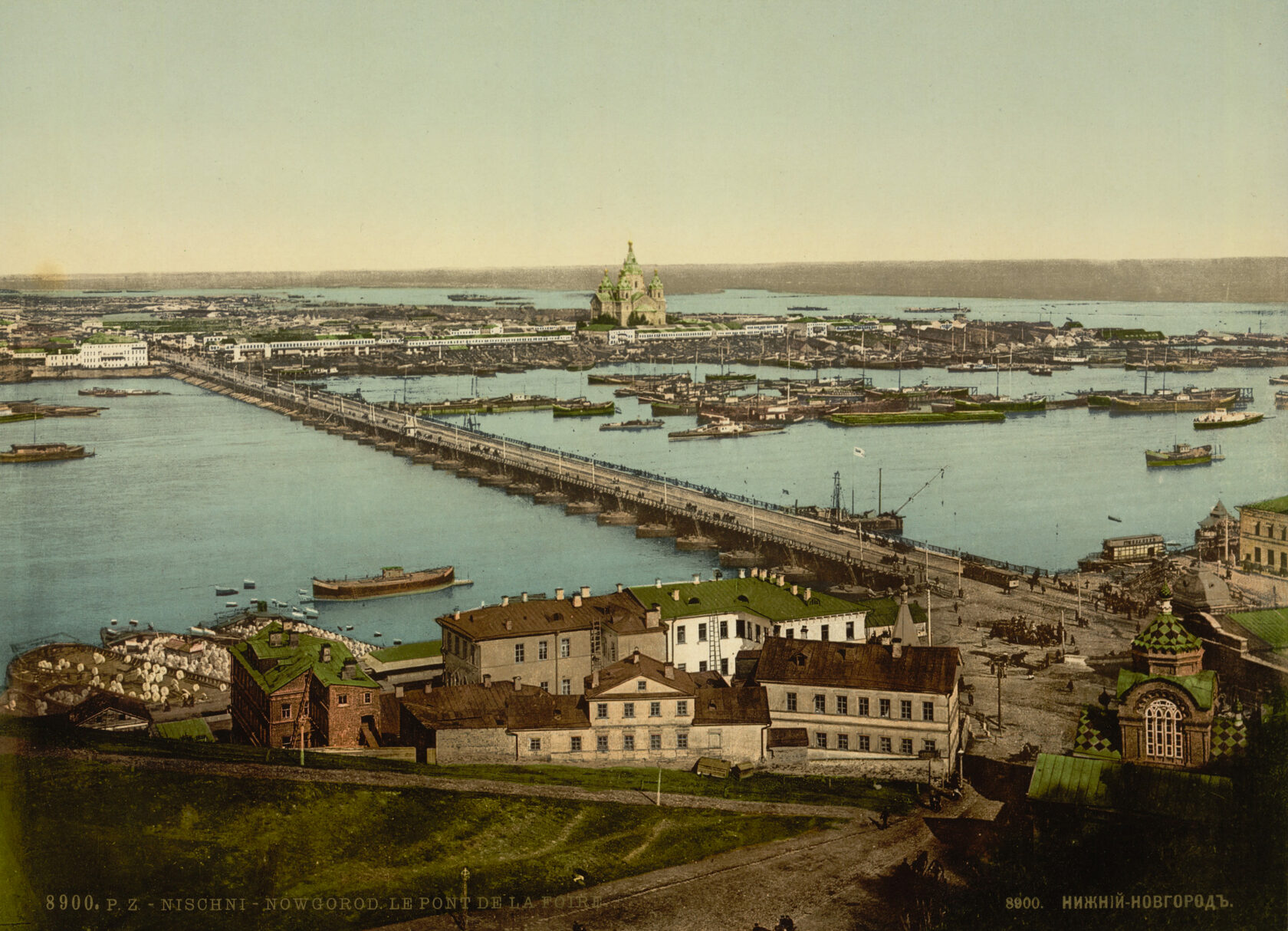
View of Nizhny Novgorod from the Oka River. Artist Jacob Nicklaus, 1798. State Hermitage Museum, Saint Petersburg
View of the Spit, Alexander Nevsky Cathedral, and the pontoon bridge in Nizhny Novgorod. Postcard, 1890-1900. Detroit Publishing Company, 1905. Library of Congress
 |  |  |
Today, buildings and structures connected with the history of the place and the city can still be found on the Spit: the Alexander Nevsky Cathedral, the fair’s filtration plant, the rows of buildings of the former ‘stitching’ and ‘beverage’ rows of the fair, the Nikitin Hotel and the Ermolaev Hotel, packhouses, the anchor of the Gorky river port, and the inscription ‘Strelka’ masoned on the quay wall in 1967.
Reopened for the 800th anniversary of the city, the Spit gives us the opportunity not only to touch the history of the city an the whole country, but also to feel the sweep of a unique natural ensemble — the confluence of the Oka and Volga rivers.
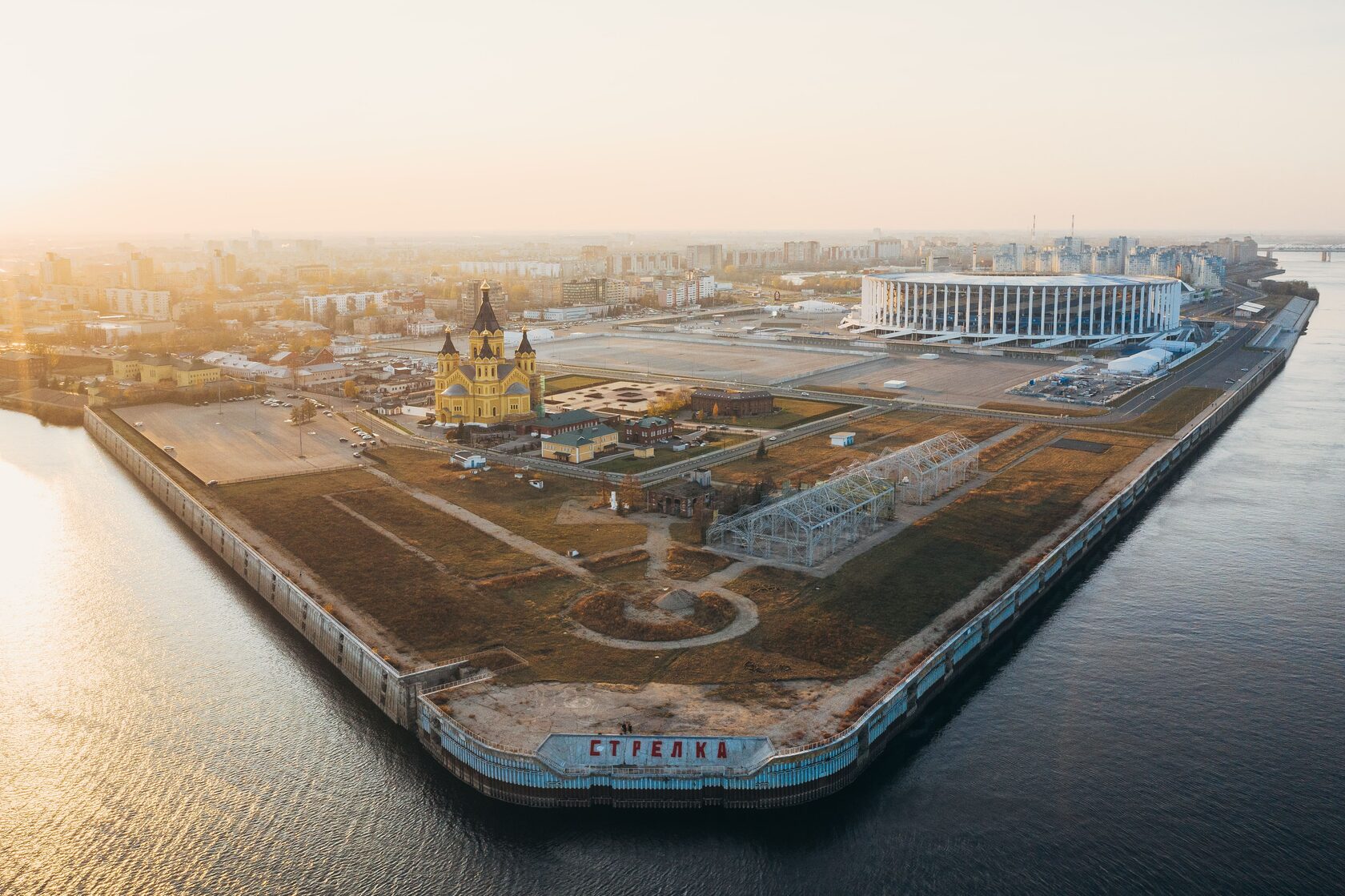
Former Warehouses
Alexander Nevsky Cathedral
Strelka Cape
Nikitin Hotel
Water Filter Station
Nizhny Novgorod Stadium
Volga River
Oka River
Gostinitsa Yermolayevikh
Before the Spit was called Strelitsa, when did it become part of Nizhny Novgorod?
Already in the 16th century, Strelitsa was an urban area. Prior to the beginning of the 19th century, the plots here belonged to various owners, including the Kunavinskaya Sloboda, the Pechersky Monastery, and the Stroganov and Shakhovsky noblemen. The lakes and rivers were used for their resources, there were plentiful greenlands, and smithies, mills, and outbuildings were located here.
What are the most important events related to the rivers?
In 1817, the famous Makaryevskaya fair was moved to Nizhny Novgorod and over the course of the century, the Spit coast developed as a territory of quays, piers, storage sheds and warehouses. Gradually the ‘stitching’ and ‘beverage’ rows of the fair were extended to the Spit along with additional features: at the request of those working around the clock on the piers, a new fair church was erected, the Alexander Nevsky Cathedral (1868 -1881), and private hotels were built, the Ermolaev Hotel (1869), and the Nikitin Hotel (1881) of the fairground circus owners. There was a water pumping station for the fair’s water supply on the Spit. In 1909 it was replaced by a new filtration plant in the Art Nouveau style with modern purification equipment.
After the closing-down of the fair in the early 1930s, the construction of a river cargo port began on the Spit. Well-equipped piers with a vertical concrete block wall on a pile foundation appeared for the first time on the Volga River. Two reinforced concrete warehouses on the Oka River (demolished in 2017) were designed by the Narkomvod architectural bureau, headed by A. Z. Grinberg (author of the House of Soviets in the Nizhny Novgorod Kremlin). These were experimental facilities using new technologies and part of the modern transport infrastructure of the Volga River. The port on the Spit was a closed, restricted access site, and at the same time, the most important junction of an international transport corridor, ‘a port of five seas.’
After the closing-down of the fair in the early 1930s, the construction of a river cargo port began on the Spit. Well-equipped piers with a vertical concrete block wall on a pile foundation appeared for the first time on the Volga River. Two reinforced concrete warehouses on the Oka River (demolished in 2017) were designed by the Narkomvod architectural bureau, headed by A. Z. Grinberg (author of the House of Soviets in the Nizhny Novgorod Kremlin). These were experimental facilities using new technologies and part of the modern transport infrastructure of the Volga River. The port on the Spit was a closed, restricted access site, and at the same time, the most important junction of an international transport corridor, ‘a port of five seas.’
Was the port closed in order to open the Spit?
As far back as in the 1960s, in town planning documents the location of the industrial zone on the Spit was found impractical. The closing-down of the port only became possible with the construction of a stadium for the 2018 World Cup. As a result, there are several facilities that remain there which are directly related to the history of this place and the city of Nizhny Novgorod.
Today the Spit is becoming accessible for all - for research, creative experimentation, and leisure. A new page in its fate gives us the opportunity to feel a sense of engagement with this symbolic place, to comprehend the unique meaning and cultural potential of the Spit.
Today the Spit is becoming accessible for all - for research, creative experimentation, and leisure. A new page in its fate gives us the opportunity to feel a sense of engagement with this symbolic place, to comprehend the unique meaning and cultural potential of the Spit.
'PACKHOUSES'
Also known as Pavilions of the All-Russian Exhibition of 1896 and former warehouses structures.
Spatial diagram of packhouses.
Source: Engineering Survey of the Technical Condition of Building Structures, Nizhny Novgorod State University of Architecture and Civil Engineering, 2017
Spatial diagram of packhouses.
Source: Engineering Survey of the Technical Condition of Building Structures, Nizhny Novgorod State University of Architecture and Civil Engineering, 2017
Metal structures are the framework of the warehouses of the Nizhny Novgorod fair and the Gorky river port, hence their name ‘packhouses.’ These warehouses were in use for over a century on the Spit of Nizhny Novgorod, or ‘Strelka’ as it is known in Russian. Originally the structures were made to be pavilions at the All-Russia Industrial and Art Exhibitions held in Moscow in 1882 and in Nizhny Novgorod in 1896.
Lightweight and elegant in design, the structures are composed of columns, arches, and trusses that are assembled from steel angles and strips, fastened with rivets, and are capable of supporting heavy loads.
The large-span structures much-in-demand in the 19th century — the ‘century of exhibitions’ — were created as open-plan, see-through spaces for exhibits and spectators and demonstrated cutting-edge industrial technologies, engineering achievements, the exchange of ideas and goods on a whole new level
The large-span structures much-in-demand in the 19th century — the ‘century of exhibitions’ — were created as open-plan, see-through spaces for exhibits and spectators and demonstrated cutting-edge industrial technologies, engineering achievements, the exchange of ideas and goods on a whole new level
The packhouses are material heritage of engineering design and the technological innovations of the past, giving evidence of the country's intellectual and industrial capabilities.
'PACK-HOUSES'


Who made them and how did they end up in Nizhny Novgorod?
The structures were made at the St. Petersburg Metalworks Plant in 1882 for the All-Russia Exhibition in Moscow. Later on in various years expositions were held in these pavilions at Khodynskoye Pole. During the preparation of the next All-Russia exhibition, this time in Nizhny Novgorod, the decision was made to bring the pavilion framework from Moscow, and so in 1893 the pavilion began to be assembled at a new location.
Why are the packhouses located on the Spit?
At the end of the Exhibition, the structures were sold off piece by piece so several fragments ended up on the piers of the Nizhny Novgorod fair. In the 1960s, the port warehouses with metal structures were rebuilt and renovated.
The port was a restricted area, and for a long time no one had given a thought to the historical value of the metal structures of the warehouses. In 2015, after an architectural excursion to the Spit, a hypothesis was made about the origin of the openwork structures. In 2017, documentary evidence confirmed that these structures are a unique monument of Russian engineering ideas from the last third of the 19th century.
The port was a restricted area, and for a long time no one had given a thought to the historical value of the metal structures of the warehouses. In 2015, after an architectural excursion to the Spit, a hypothesis was made about the origin of the openwork structures. In 2017, documentary evidence confirmed that these structures are a unique monument of Russian engineering ideas from the last third of the 19th century.
CO-CREATION
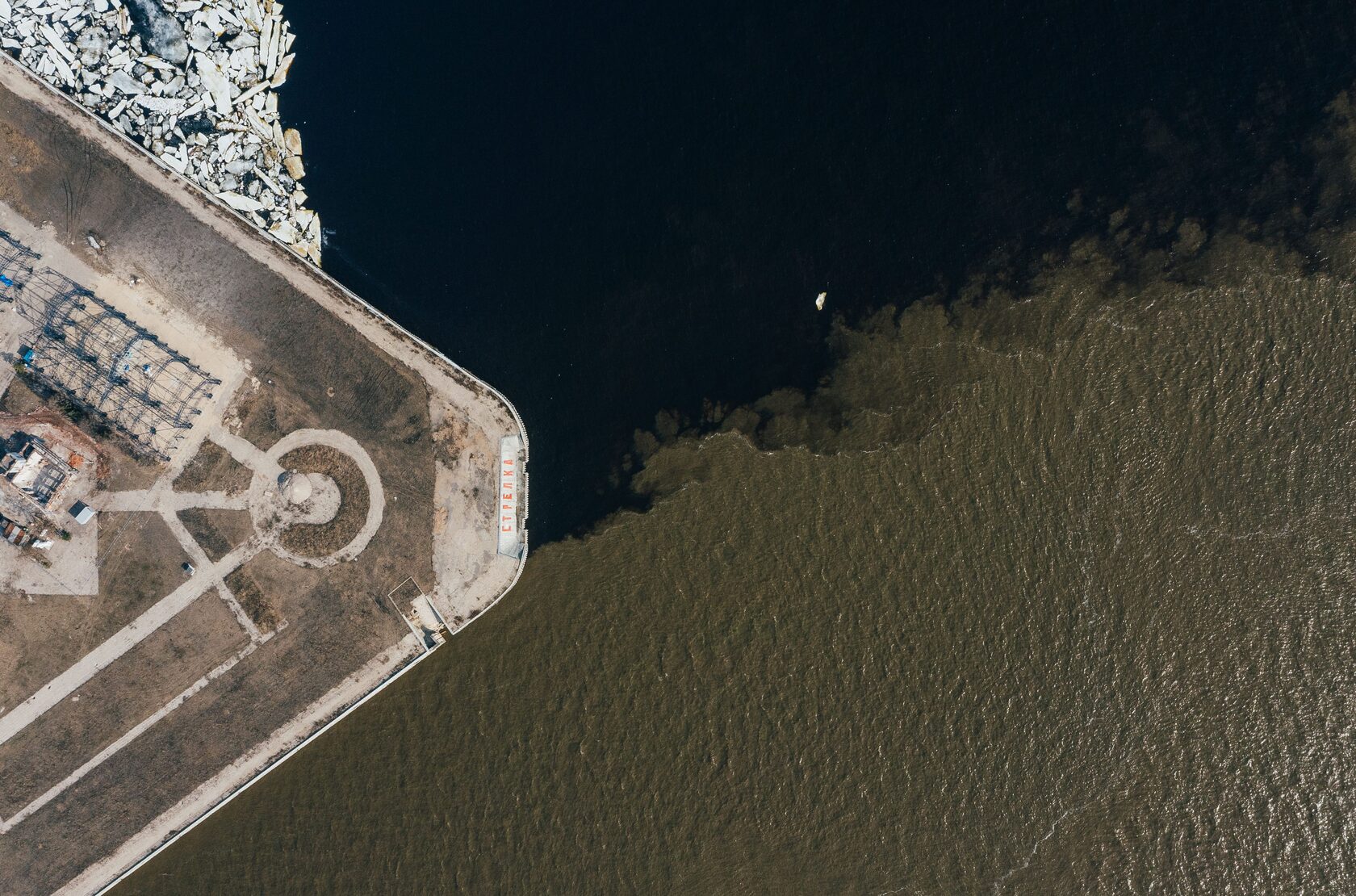
Many cities are located along rivers, even at the confluence of rivers, but the Nizhny Novgorod Spit of the Oka and Volga rivers is unique. Nowhere in the world have large rivers formed a landscape with such a significant difference in elevation. This geological phenomenon has provided for the structural make-up of modern-day Nizhny Novgorod: the upland part and the part situated on the other side of the river. Looking from the Spit, it is easy to imagine how this relief has been built over millions of years, to observe the natural elements, to reflect on the centuries of the city's development, to peer at its skyline and think: what else will change over time?
The Spit also has air currents. Here the strongest winds, coming from the west and south, collide and whirl. Eight centuries ago, they brought the ships of Prince Yuri Vsevolodovich here, where the Dyatlov Hills lay before him, the location for a future outpost. The special atmosphere of the Spit is due to the wind: it makes you feel more intensely, not make a fuss, and choose what is most important. This is the place to reset projects, plans, aspirations and intentions.
Nature created the surrounding landscape slowly. The Spit itself has changed significantly over the past two centuries: the concrete quay walls have given the cape geometrically correct outlines. The Krugloye and Barantsevo lakes have disappeared from the map; the area has risen above the rivers, flush with the roadbed under the highway along Sovetskaya Street.
Now the Spit is a joint creation of man and nature, an active place where the city and the elements meet. It is a symbol of quests and change. The Spit is part of the cultural landscape of the great rivers.
The Spit also has air currents. Here the strongest winds, coming from the west and south, collide and whirl. Eight centuries ago, they brought the ships of Prince Yuri Vsevolodovich here, where the Dyatlov Hills lay before him, the location for a future outpost. The special atmosphere of the Spit is due to the wind: it makes you feel more intensely, not make a fuss, and choose what is most important. This is the place to reset projects, plans, aspirations and intentions.
Nature created the surrounding landscape slowly. The Spit itself has changed significantly over the past two centuries: the concrete quay walls have given the cape geometrically correct outlines. The Krugloye and Barantsevo lakes have disappeared from the map; the area has risen above the rivers, flush with the roadbed under the highway along Sovetskaya Street.
Now the Spit is a joint creation of man and nature, an active place where the city and the elements meet. It is a symbol of quests and change. The Spit is part of the cultural landscape of the great rivers.
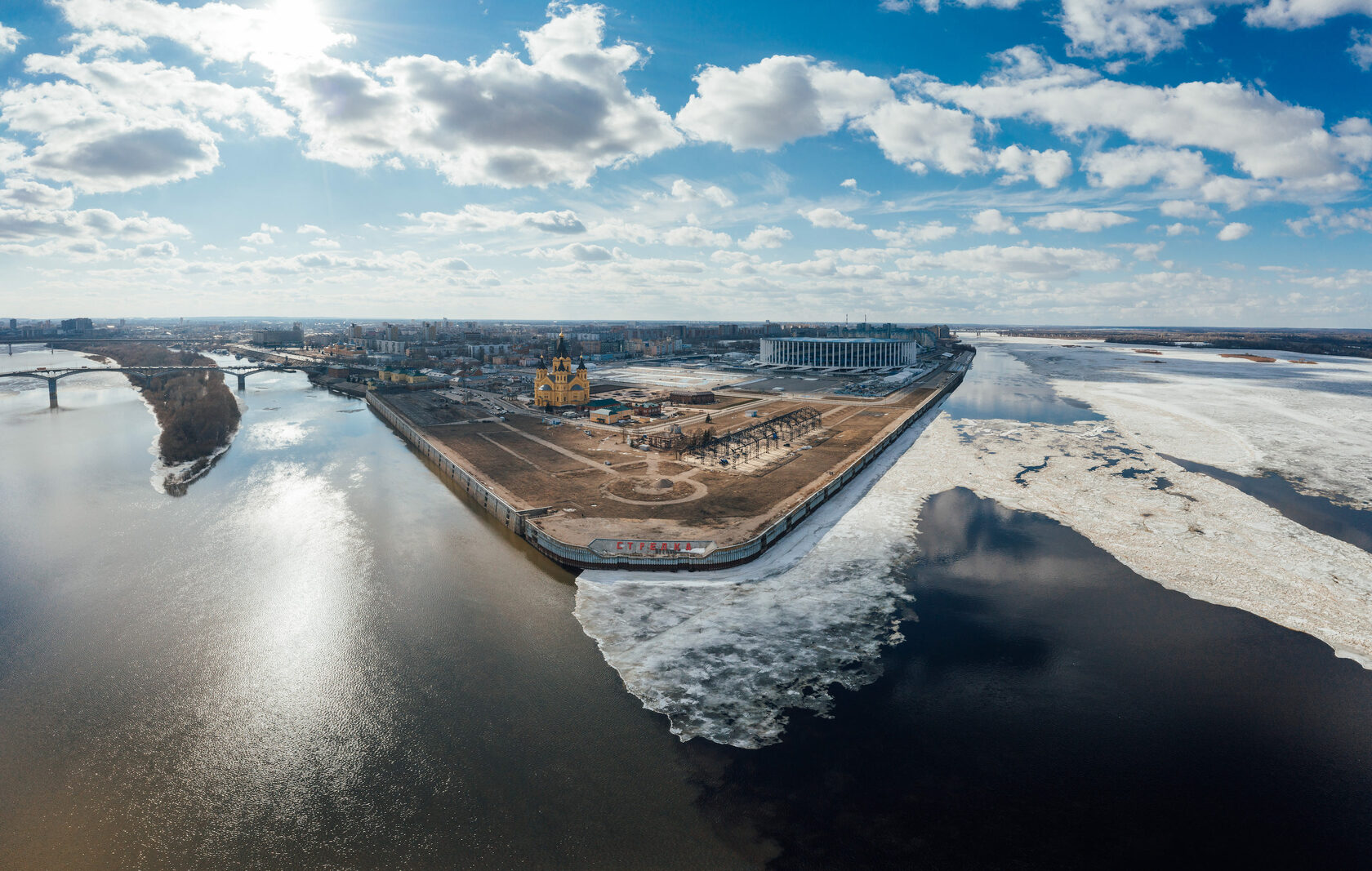
The confluence of the Oka and Volga rivers, 2021. Photo: Dima Chetyre
Ice drift at the Spit, 2021. Photo: Dima Chetyre
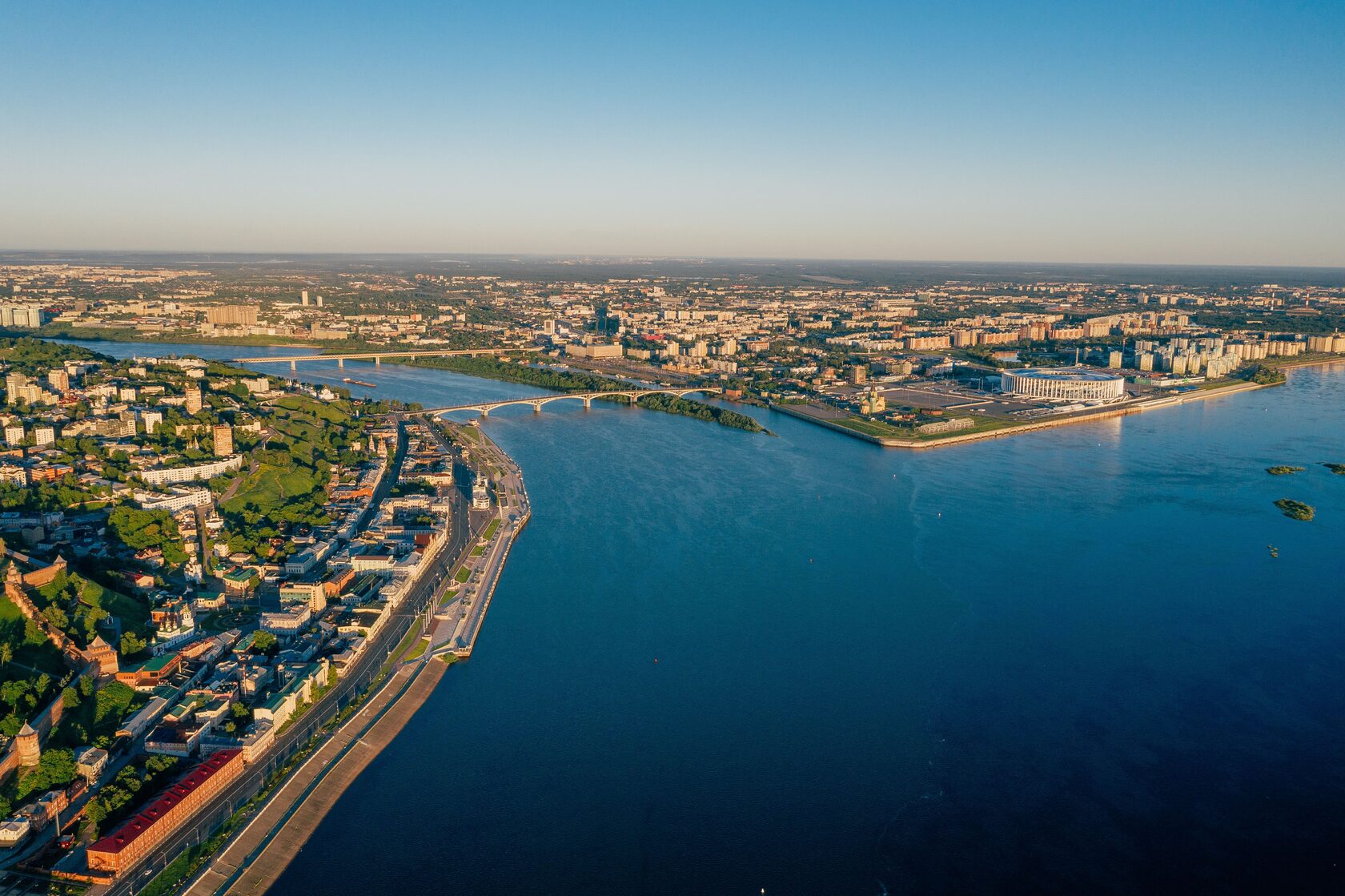
View of the Spit and key sites, 2021. Photo: Dima Chetyre
What is a cultural landscape?
The Spit’s territory is part of the natural framework of the city and at the same time part of its cultural landscape. The cultural landscape is a special type of heritage based on the interaction and interrelatedness of nature, history, geography, economy, and culture. UNESCO identifies three categories of cultural landscapes: man-made, evolved, associative. Based on its qualities and components, the Spit corresponds to all three categories at once. Geological evolution, historical events and facts, and engineering designs - all of it is collected in a treasury of universal values.
Is it possible to grasp why it is so beautiful here?
Even the emotional impact of the Spit can be appreciated. On a scale of aesthetic characteristics of the landscape, everything on the Spit is superb! It has a landscape full of contrasts; the intensity and variety of perspectives, relief, and textures. The color of the landscape changes not only according to the seasons or the weather, but also depending on the light at different times of the day. Natural, cultural and symbolic attractions enrich this landscape.
© 2021 ИРГСНО
have
a nice day
at 'strelka'!
a nice day
at 'strelka'!
Here you can learn more about the improvement of the territory of the Spit in 2021.










